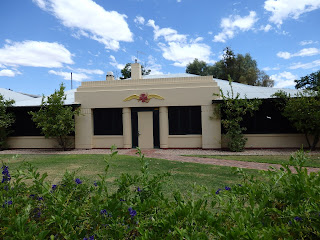As a decade birthday gift for Erick, we signed up for "Exploring Australia and New Zealand," a University of Michigan Alumni tour coordinated by Odysseys International. This post covers the Alice Springs, Standley Chasm and Simpsons Gap portions of our trip. (You can click on a photo to see a larger version.)
Day 6: Flew to Alice Springs in the Northern Territory (the Outback, Never Never). Visited the Royal Flying Doctors Centre and the School of the Air. People are spread out widely over Australia and delivering health care via the air is essential. Children in the Northern Territory often live far from physical school buildings – online and correspondence courses make education possible.
 |
| Australia's Red Center, the Outback, from our plane |
 |
| On the way from the airport to Alice Springs |
 |
| Near the old Alice Springs site |
While stopping by the original Alice Springs site, we saw our first kangaroo in the wild (a rarer sight now than it once was).
 |
| Click to enlarge the photo, and see a kangaroo with a bird on its back |
We stopped at ANZAC Hill on the outskirts of Alice Spring - one of many memorials in Australia and New Zealand honoring soldiers who fought in WWII, WWI and more recent conflicts.
 |
| Alice Springs from ANZAC Hill |
The Royal Flying Doctors Service - health care delivery over a large country with cities and towns spread far apart:
 |
RFDS plane |
 |
| Hologram movie of the founding of the RFDS |
 |
| Anniversary quilt - founder John Flynn in the center |
The School of the Air - Australia's way of educating students who are spread over a wide geographic area. The School started back in the days of radio and now uses the Internet to connect teachers, students and their home tutors who are often their parents.
 |
| School of the Air staff members shows where students are from |
 |
| Quilt with student panels showing scenes from their home areas |
About the environment of Alice Springs:
 |
Water flows below the surface of the rivers. Dig into the sand in the
right place and find that the hole fills with water from underground. |
 |
| Crested pigeons |
 |
| Bearded dragon |
Day 7: Our day in the Outback included an introduction by local guide Andrew to the culture of the aboriginal people living nearby – the implements used for hunting and gathering, a boomerang demonstration, and a chance to meet dot painting artists. We bought two paintings – one depicting “bush tucker” (food that the women gatherers find in the wild), the other snakes and lizards.
 |
| Getting ready to sample roasted kangaroo tail, a bush tucker delicacy |
On the road to the day's hiking sites:
Stanley Chasm (Angkerle Atwatye, its aboriginal name represents the food and water to be found there) provided an occasion for a hike and then lunch. The site is privately owned and managed by an aboriginal cooperative.
In the evening, we enjoyed a bush barbecue prepared by Cath, got a lesson in baking “spotted dog” from her husband Jim, were entertained by Tim – with a guest “appearance” (we never actually saw it) from the poisonous but rarely seen King Brown snake. Later Andrew pointed out stars in the Southern Cross.
 |
Tim serenades us. Later in the evening, Joan, a member of our
group and accomplished singer, sang "Getting to Know You". |
 |
Jim prepares to make "spotted dog," an Irish soda bread
made with flour, baking soda, oil, milk, and raisins;
and baked using coals, Outback-style. |
 |
| The evening progresses |
 |
| Spotted dog baking |
 |
A local snake expert hunting for the poisonous Brown King snake that
crashed our barbecue dinner. They are shy of people and it slipped away. |
 |
Our dessert, two loaves of spotted dog.
One dressed up as a birthday cake for a member of our tour group. |
 |
| Outback sunset |
Next up, Exploring Australia, Part 3, Uluru and Kata Tjuta

























































No comments:
Post a Comment